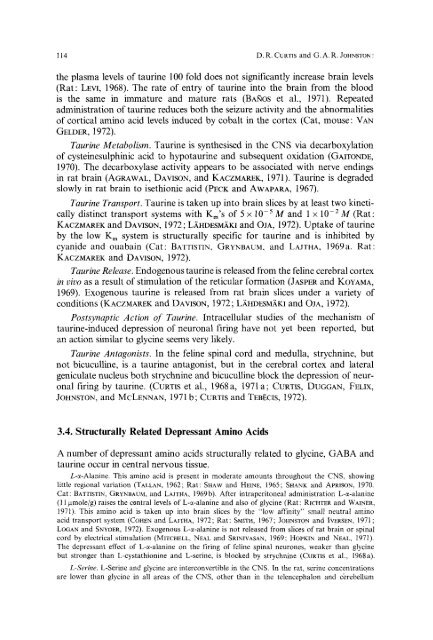Amino acid transmitters in the mammalian central nervous system
Amino acid transmitters in the mammalian central nervous system
Amino acid transmitters in the mammalian central nervous system
Create successful ePaper yourself
Turn your PDF publications into a flip-book with our unique Google optimized e-Paper software.
114 D.R. CURTIS and G.A.R. JOHNSTON :<br />
<strong>the</strong> plasma levels of taur<strong>in</strong>e 100 fold does not significantly <strong>in</strong>crease bra<strong>in</strong> levels<br />
(Rat: LEVI, 1968). The rate of entry of taur<strong>in</strong>e <strong>in</strong>to <strong>the</strong> bra<strong>in</strong> from <strong>the</strong> blood<br />
is <strong>the</strong> same <strong>in</strong> immature and mature rats (BASOS et al., 1971). Repeated<br />
adm<strong>in</strong>istration of taur<strong>in</strong>e reduces both <strong>the</strong> seizure activity and <strong>the</strong> abnormalities<br />
of cortical am<strong>in</strong>o <strong>acid</strong> levels <strong>in</strong>duced by cobalt <strong>in</strong> <strong>the</strong> cortex (Cat, mouse: VAN<br />
GELDER, 1972).<br />
Taur<strong>in</strong>e Metabolism. Taur<strong>in</strong>e is syn<strong>the</strong>sised <strong>in</strong> <strong>the</strong> CNS via decarboxylation<br />
of cyste<strong>in</strong>esulph<strong>in</strong>ic <strong>acid</strong> to hypotaur<strong>in</strong>e and subsequent oxidation (GAITONDE,<br />
1970). The decarboxylase activity appears to be associated with nerve end<strong>in</strong>gs<br />
<strong>in</strong> rat bra<strong>in</strong> (AGRAWAL, DAVISON, and KACZMAREK, 1971). Taur<strong>in</strong>e is degraded<br />
slowly <strong>in</strong> rat bra<strong>in</strong> to isethionic <strong>acid</strong> (PECK and AWAPARA, 1967).<br />
Taur<strong>in</strong>e Transport. Taur<strong>in</strong>e is taken up <strong>in</strong>to bra<strong>in</strong> slices by at least two k<strong>in</strong>etically<br />
dist<strong>in</strong>ct transport <strong>system</strong>s with Km's of 5 x l0 -5 M and 1 x 10 -2 M (Rat:<br />
KACZMAREK and DAVlSON, 1972 ; LAHDESMAKI and OJA, 1972). Uptake of taur<strong>in</strong>e<br />
by <strong>the</strong> low K m <strong>system</strong> is structurally specific for taur<strong>in</strong>e and is <strong>in</strong>hibited by<br />
cyanide and ouaba<strong>in</strong> (Cat: BATTISTIN, GRYNBAUM, and LAJTHA, 1969a. Rat:<br />
KACZMAREK and DAVISON, 1972).<br />
Taur<strong>in</strong>e Release. Endogenous taur<strong>in</strong>e is released from <strong>the</strong> fel<strong>in</strong>e cerebral cortex<br />
<strong>in</strong> vivo as a result of stimulation of <strong>the</strong> reticular formation (JASPER and KOYAMA,<br />
1969). Exogenous taur<strong>in</strong>e is released from rat bra<strong>in</strong> slices under a variety of<br />
conditions (KACZMAREK and DAVISON, 1972; LAHDESMXKI and OJA, 1972).<br />
Postsynaptic Action of Taur<strong>in</strong>e. Intracellular studies of <strong>the</strong> mechanism of<br />
taur<strong>in</strong>e-<strong>in</strong>duced depression of neuronal fir<strong>in</strong>g have not yet been reported, but<br />
an action similar to glyc<strong>in</strong>e seems very likely.<br />
Taur<strong>in</strong>e Antagonists. In <strong>the</strong> fel<strong>in</strong>e sp<strong>in</strong>al cord and medulla, strychn<strong>in</strong>e, but<br />
not bicucull<strong>in</strong>e, is a taur<strong>in</strong>e antagonist, but <strong>in</strong> <strong>the</strong> cerebral cortex and lateral<br />
geniculate nucleus both strychn<strong>in</strong>e and bicucull<strong>in</strong>e block <strong>the</strong> depression of neuronal<br />
fir<strong>in</strong>g by taur<strong>in</strong>e. (CURTIS et al., 1968a, 1971 a; CUP, T~S, DUGGAN, FELIX,<br />
JOHNSTON, and MCLENNAN, 1971 b; CURTIS and TEB~CtS, 1972).<br />
3.4. Structurally Related Depressant <strong>Am<strong>in</strong>o</strong> Acids<br />
A number of depressant am<strong>in</strong>o <strong>acid</strong>s structurally related to glyc<strong>in</strong>e, GABA and<br />
taur<strong>in</strong>e occur <strong>in</strong> <strong>central</strong> <strong>nervous</strong> tissue.<br />
L-c~-Alan<strong>in</strong>e. This am<strong>in</strong>o <strong>acid</strong> is present <strong>in</strong> moderate amounts throughout <strong>the</strong> CNS, show<strong>in</strong>g<br />
little regional variation (TALLAN, 1962; Rat: SHAW and HHNE, 1965; SI~ANK and APmSON, 1970.<br />
Cat: BATXISTIN, GRYNBAU~4, and LAJTHA, 1969b). After <strong>in</strong>traperitoneal adm<strong>in</strong>istration L-e-alan<strong>in</strong>e<br />
(11 gmole/g) raises <strong>the</strong> csntral levels of L-c~-alan<strong>in</strong>e and also of glyc<strong>in</strong>e (Rat: RICHTER and WA1NER,<br />
1971). This am<strong>in</strong>o <strong>acid</strong> is taken up <strong>in</strong>to bra<strong>in</strong> slices by <strong>the</strong> "low aff<strong>in</strong>ity" small neutral am<strong>in</strong>o<br />
<strong>acid</strong> transport <strong>system</strong> (COHEN and LmTHA, 1972; Rat: SMmt, 1967; JOHNSTON and IVERSEN, 1971;<br />
LOGAN and SNYDER, 1972). Exogenous L-e-alan<strong>in</strong>e is not released from slices of rat bra<strong>in</strong> or sp<strong>in</strong>al<br />
cord by electrical stimulation (MITCHELL, NEAL and SRIMVASAN, 1969; HOVKIN and NEAL, 1971).<br />
The depressant effect of L-ct-alan<strong>in</strong>e on <strong>the</strong> fir<strong>in</strong>g of fel<strong>in</strong>e sp<strong>in</strong>al neurones, weaker than glyc<strong>in</strong>e<br />
but stronger than L-cystathion<strong>in</strong>e and L-ser<strong>in</strong>e, is blocked by strychn<strong>in</strong>e (CURTIS et al., 1968a).<br />
L-Ser<strong>in</strong>e. L-Ser<strong>in</strong>e and glyc<strong>in</strong>e are <strong>in</strong>terconvertible <strong>in</strong> <strong>the</strong> CNS. In <strong>the</strong> rat, ser<strong>in</strong>e concentrations<br />
are lower than glyc<strong>in</strong>e <strong>in</strong> all areas of <strong>the</strong> CNS, o<strong>the</strong>r than <strong>in</strong> <strong>the</strong> telencephalon and c~rebellum













